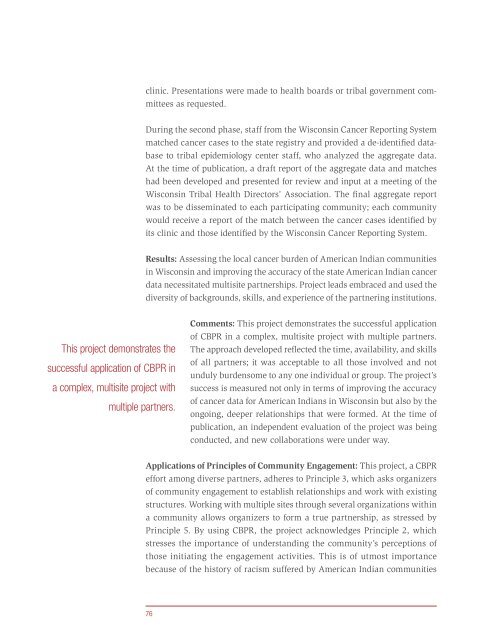Principles of Community Engagement (Second Edition)
Principles of Community Engagement (Second Edition)
Principles of Community Engagement (Second Edition)
Create successful ePaper yourself
Turn your PDF publications into a flip-book with our unique Google optimized e-Paper software.
This project demonstrates the<br />
successful application <strong>of</strong> CBPR in<br />
a complex, multisite project with<br />
multiple partners.<br />
clinic Presentations were made to health boards or tribal government com-<br />
mittees as requested<br />
During the second phase, staff from the Wisconsin Cancer Reporting System<br />
matched cancer cases to the state registry and provided a de-identified database<br />
to tribal epidemiology center staff, who analyzed the aggregate data<br />
At the time <strong>of</strong> publication, a draft report <strong>of</strong> the aggregate data and matches<br />
had been developed and presented for review and input at a meeting <strong>of</strong> the<br />
Wisconsin Tribal Health Directors’ Association The final aggregate report<br />
was to be disseminated to each participating community; each community<br />
would receive a report <strong>of</strong> the match between the cancer cases identified by<br />
its clinic and those identified by the Wisconsin Cancer Reporting System<br />
Results: Assessing the local cancer burden <strong>of</strong> American Indian communities<br />
in Wisconsin and improving the accuracy <strong>of</strong> the state American Indian cancer<br />
data necessitated multisite partnerships Project leads embraced and used the<br />
diversity <strong>of</strong> backgrounds, skills, and experience <strong>of</strong> the partnering institutions<br />
76<br />
Comments: This project demonstrates the successful application<br />
<strong>of</strong> CBPR in a complex, multisite project with multiple partners<br />
The approach developed reflected the time, availability, and skills<br />
<strong>of</strong> all partners; it was acceptable to all those involved and not<br />
unduly burdensome to any one individual or group The project’s<br />
success is measured not only in terms <strong>of</strong> improving the accuracy<br />
<strong>of</strong> cancer data for American Indians in Wisconsin but also by the<br />
ongoing, deeper relationships that were formed At the time <strong>of</strong><br />
publication, an independent evaluation <strong>of</strong> the project was being<br />
conducted, and new collaborations were under way<br />
Applications <strong>of</strong> <strong>Principles</strong> <strong>of</strong> <strong>Community</strong> <strong>Engagement</strong>: This project, a CBPR<br />
effort among diverse partners, adheres to Principle 3, which asks organizers<br />
<strong>of</strong> community engagement to establish relationships and work with existing<br />
structures Working with multiple sites through several organizations within<br />
a community allows organizers to form a true partnership, as stressed by<br />
Principle 5 By using CBPR, the project acknowledges Principle 2, which<br />
stresses the importance <strong>of</strong> understanding the community’s perceptions <strong>of</strong><br />
those initiating the engagement activities This is <strong>of</strong> utmost importance<br />
because <strong>of</strong> the history <strong>of</strong> racism suffered by American Indian communities

















